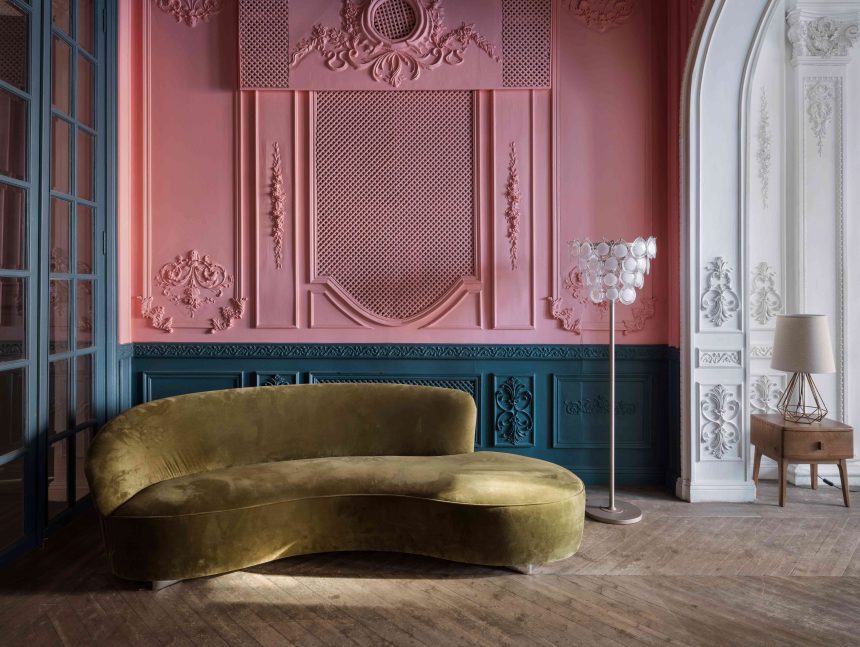We’re all familiar with the design industry’s aesthetic carousel. One week, the modern farmhouse aesthetic fills social media feeds, and the next, everyone is talking about minimalism. It can be hard to keep up as different looks wax and wane in popularity, but one thing remains constant no matter what direction your interiors lean: vintage pieces will never go out of style.
Whether it’s a striking 1980s chrome lamp or a midcentury sofa, incorporating vintage furniture and décor into your space is a statement-making—and sustainable—choice. However, even in this marketplace, some pieces are more popular than others. Here, we spoke to industry experts to find out which vintage furniture trends we should keep an eye on in 2025.
- David Fox, architect and co-founder of Stonefox design firm
- Daniella Villamil, interior designer and founder of her eponymous studio
- Melissa Lee, interior designer and founder and principal of Bespoke Only
Why It’s Important
“The benefits of vintage are many,” says architect David Fox, who runs design firm Stonefox alongside fellow architect Chris Stone. “It’s using something that already exists on the planet rather than buying something new that might not be as high quality. We really like to have things from different periods and decades in a room—it’s more interesting.”
Interior designer Daniella Villamil agrees. Although her work leans contemporary, she loves to incorporate antique art and furniture to give her clients highly personalized spaces. “Vintage pieces have a charm and quality that mass-produced items don’t,” she says. “They can also have unique details, like carvings or materials that are no longer widely available—there’s a history that adds character and depth to a space.”
Art Deco
Interior Design by JAM Studios
Following a recent resurgence on certain fashion runways around the globe, Art Deco is taking center stage in the furniture sector—one century after it first debuted. “[It’s] a vibrant response to the reserved and organic interiors that have been trending in recent years,” says Villamil. “This revival brings new appreciation for geometric shapes, bold colors, and materials, adding depth and dynamism to interiors.”
Instead of overhauling your entire home to look like Gatsby’s mansion, Villamil suggests starting small with impactful accents that complement your home. “Think geometric patterns for throw pillows or rugs,” she says. “If your budget allows, invest in a statement chandelier or table lamps with angular designs.”
Antique Chinese Rugs
Getty / Tony Anderson
Furniture is incomplete without a rug to ground it. And while everyone knows about vintage Moroccan rugs, interior designer Melissa Lee says that the popularity of antique Chinese rugs is on the rise. While the former textiles tend to have a more bohemian appearance with geometric shapes, textured wool, and a looser weave, Chinese rugs often incorporate silk and feature more intricate patterns, creating a more refined look.
When mixed with contemporary furniture, they can add polish to a room, Lee says. “But definitely keep the [color] palette in mind when considering the rest of the space—don’t match exactly, but be complementary,” she notes.
Biomorphic Furniture
Getty / Andreas von Einsiedel
Emerging in the 1940s and ’50s, biomorphic design has held steady over the years as a creative touchstone. Its practitioners use shapes and patterns found in nature as the basis for their best-known designs—heavy hitters include Vladimir Kagan, Eero Saarinen, the Eameses, and Isamu Noguchi. These amoebic, rounded forms bring a sense of softness to any room, creating a more calming atmosphere than one full of sharp-edged pieces.
“Biomorphic design was a response to the ornate designs before World War II,” says Villamil. “Likewise, after Covid, there was a shift in how we related to our surroundings and what we seek from them. Rounded and organic shapes evoke comfort and ease that creates a sense of wellbeing and connection with nature, reducing stress and improving cognitive functions.”
Early Philippe Starck
Getty / Andreas von Einsiedel
Recently, Fox and Stone have seen a renewed interest in the early work of French industrial designer Philippe Starck. Starck has designed a long list of iconic products, both under his own name and for the likes of Emeco, Alessi, and Kartell. He often took ordinary household items, like chairs or citrus juicers, and reimagined them in innovative, aesthetic-forward ways.
“We recently acquired a vintage [Philippe Starck] table for a client,” says Stone. “It was designed to fold flat and be easy to assemble, which harkens back to the smart industrial designs of Jean Prouvé.”
He goes on to say that it’s not just Starck’s early work that’s worth a second look, naming Vladimir Kagan’s Rockstar rocker and Italian architect Gae Aulenti’s Parola lamp (a collaboration with Piero Castiglioni) as standout examples. “Perhaps the trend is more about finding these quintessential or seminal works by designers that transcend history and are timeless,” he says.
Low Modular Sectionals
Getty / Victoriia Kovalchuk
Substantial furniture is making a comeback. According to Villamil, her firm is getting more requests for pieces that “evoke feelings of nostalgia and warmth.” In many cases, that includes heftier sofas that encourage lounging—much like the ones designed between the ’60s and ’80s. One example, she says, is a popular Ligne Roset seat.
“In an era where digital immersion has created feelings of isolation, our homes have become the sanctuaries where we seek to create comfort and connection,” she continues. “The Togo [designed by Michel Ducaroy in 1973], with its low profile and modular arrangement, represents ease and adaptability and goes beyond aesthetics to prove that comfort and style are never mutually exclusive.”
Another perk of modular furniture is its flexibility, which, according to Villamil, allows you to play with different configurations and adapt the space over time.
Lacquer and Burl wood
Lisa-Blue / Getty images
White oak and concrete have had their time in the spotlight. Now, Lee is seeing furniture with interesting finishes—specifically burl wood and lacquer—recirculating. “Vintage has the magic of inserting an instant, time-worn warmth,” she says. “It gives the space a sense of authenticity and a layer of narrative, which turns a room into a real home. It’s simply s irreplaceable.”
Pieces made with burl wood or finished in lacquer have a certain midcentury glamour that Lee thinks works best when paired with contemporary designs. “They’re very versatile when mixed with modern furniture,” she says. “There’s a classic, polished aesthetic in lacquer and burl wood without being ostentatiously shiny.”
Anti-Design
Getty / Scott van Dyke
In a world where ideas are exchanged at the click of a button—and products are produced at breakneck speed—there’s something to be said for seeking out the unique. That’s why Fox points to the “anti-design” movement as one of the next big trends in vintage furniture.
A style that arose in the 1960s as a backlash to consumerism, the tenets of anti-design included humor or kitsch, complicated designs, bold colors, and space-saving measures (the stackable plastic chair emerged from this movement).
“There’s so much design in the world right now,” says Fox. “It’s so easy to access for everyone. This is wonderful in many respects, but the downside is that similar objects and concepts appear to be everywhere and less special.”
Fox cites vintage Gaetano Pesce pieces, with their candy-colored hues and amorphous shapes, as prime examples of anti-design. “His work is definitely in this category because he wasn’t trying to create something trendy,” she says. It takes a certain sensibility to embrace these pieces, of course—but finding an original is a near guarantee that your living room will never look the same as your neighbor’s.






